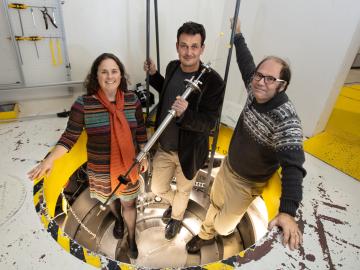
Filter News
Area of Research
- (-) Biology and Environment (101)
- (-) National Security (22)
- (-) Neutron Science (81)
- Advanced Manufacturing (5)
- Biological Systems (2)
- Biology and Soft Matter (1)
- Computational Biology (1)
- Computational Engineering (2)
- Computer Science (8)
- Electricity and Smart Grid (2)
- Energy Science (116)
- Fusion and Fission (4)
- Isotopes (3)
- Materials (47)
- Materials for Computing (10)
- Mathematics (1)
- Nuclear Science and Technology (6)
- Quantum information Science (7)
- Sensors and Controls (1)
- Supercomputing (54)
- Transportation Systems (2)
News Type
News Topics
- (-) Bioenergy (41)
- (-) Composites (2)
- (-) Environment (81)
- (-) Grid (7)
- (-) Machine Learning (15)
- (-) Mathematics (3)
- (-) Microscopy (9)
- (-) Neutron Science (77)
- (-) Quantum Science (3)
- (-) Space Exploration (2)
- (-) Transportation (4)
- 3-D Printing/Advanced Manufacturing (7)
- Artificial Intelligence (16)
- Big Data (14)
- Biology (61)
- Biomedical (21)
- Biotechnology (9)
- Buildings (1)
- Chemical Sciences (7)
- Clean Water (13)
- Computer Science (29)
- Coronavirus (12)
- Cybersecurity (9)
- Energy Storage (7)
- Exascale Computing (4)
- Fossil Energy (1)
- Frontier (3)
- High-Performance Computing (19)
- Hydropower (9)
- Materials (11)
- Materials Science (13)
- Mercury (7)
- Nanotechnology (6)
- National Security (24)
- Nuclear Energy (4)
- Partnerships (2)
- Physics (3)
- Polymers (2)
- Quantum Computing (1)
- Security (7)
- Simulation (10)
- Summit (9)
Media Contacts

Oak Ridge National Laboratory researchers working on neutron imaging capabilities for nuclear materials have developed a process for seeing the inside of uranium particles – without cutting them open.

A versatile class of flexible, protein-like polymers could significantly advance future drug delivery methods. But first, scientists have to develop a reliable process for tailoring these polymers into shapes that can effectively transport medicines throughout the human body.

Biological membranes, such as the “walls” of most types of living cells, primarily consist of a double layer of lipids, or “lipid bilayer,” that forms the structure, and a variety of embedded and attached proteins with highly specialized functions, including proteins that rapidly and selectively transport ions and molecules in and out of the cell.

A novel approach developed by scientists at ORNL can scan massive datasets of large-scale satellite images to more accurately map infrastructure – such as buildings and roads – in hours versus days.

Researchers have developed a new process that could make it much cheaper to produce biofuels such as ethanol from plant waste and reduce reliance on fossil fuels.

To better determine the potential energy cost savings among connected homes, researchers at Oak Ridge National Laboratory developed a computer simulation to more accurately compare energy use on similar weather days.

Illustration of the optimized zeolite catalyst, or NbAlS-1, which enables a highly efficient chemical reaction to create butene, a renewable source of energy, without expending high amounts of energy for the conversion. Credit: Jill Hemman, Oak Ridge National Laboratory/U.S. Dept. of Energy

ORNL computer scientist Catherine Schuman returned to her alma mater, Harriman High School, to lead Hour of Code activities and talk to students about her job as a researcher.

Scientists at the U.S. Department of Energy’s Brookhaven National Laboratory have new experimental evidence and a predictive theory that solves a long-standing materials science mystery: why certain crystalline materials shrink when heated.

Two of the researchers who share the Nobel Prize in Chemistry announced Wednesday—John B. Goodenough of the University of Texas at Austin and M. Stanley Whittingham of Binghamton University in New York—have research ties to ORNL.


